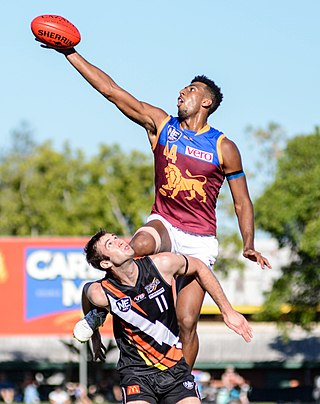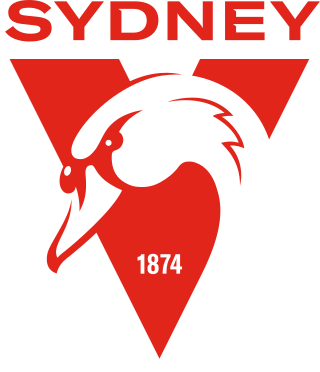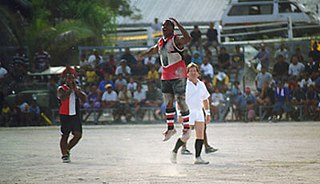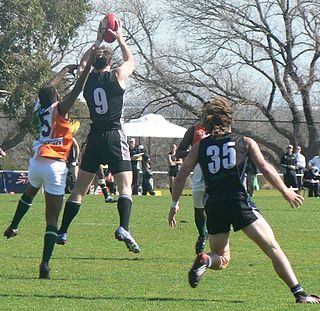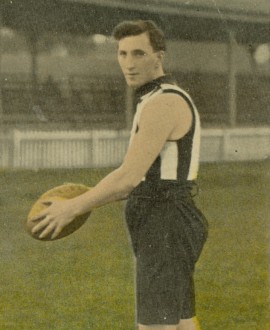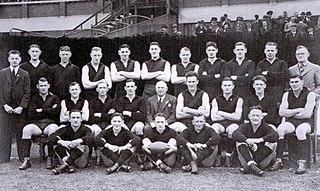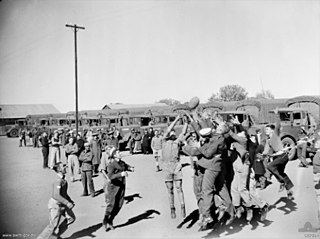Exhibition matches played outside Australia
World War I
During World War I, Australian troops organised matches across Europe, in countries with the highest profile matches been played in the United Kingdom since 1916 but also one-off matches in other countries including Belgium and France (1919).
Pioneer Exhibition Game in London

On Saturday 28 October 1916, the former Olympic champion swimmer and the later Lord Mayor of Melbourne, Lieutenant Frank Beaurepaire, organised an Australian Rules football match between two teams of Australian servicemen in aid of the British and French Red Cross. [1]
The match was promoted as a "Pioneer Exhibition Game of Australian Football in London". It was held at Queen's Club, West Kensington before an estimated crowd of 3,000, [2] which included the (then) Prince of Wales (later King Edward VIII), and King Manuel II of Portugal.
An Australian football match (an Australian Division v. Training Groups) will be played at Queen's Club, West Kensington, tomorrow, at 3 p.m., in aid of the British and French Red Cross Funds. The game, played by 18 players a side, will show how Australians have combined "Soccer" and Rugby.
The Times, Friday, 27 October 1916. [3]
The members of the competing teams, Australian Training Units and The Third Australian Divisional Team, were all highly skilled footballers, the majority of which had already played senior football in their respective states.
A news film was taken at the match. [4]
In order to celebrate the match Beaurepaire commissioned a set of team photographs that were inserted into a mounting board decorated with a British Union Jack and an Australian Red Ensign, that had "Australian Football in London. Pioneer Exhibition Game. At Queen's Club, West Kensington. Saturday 28th Oct. 1916" at its head, and "Organizer of Match & Donor of Photos to Club Lieut. Frank Beaurepaire" at its foot. [5]
World War II
During World War II, exhibition matches were played by servicemen in several countries, especially in South East Asia and also in the United Kingdom. Countries included Papua New Guinea, Indonesia, Malaysia and Vietnam. Each of these matches drew a number of interested local spectators.
1960s – 1990s
After the 1960s, the Victorian Football League, realising that finding new markets were essential to the prosperity of the competition began to belatedly pursue a series of international exhibition matches to raise the profile of the game overseas.
The longest and most persistent of these was Great Britain, which was seen as an opportunity primarily due to the high number of ex-patriate Australians living there, and the availability of cricket grounds.
The most notable series of exhibition matches was staged by the Carlton Football Club in 1972. Club president George Harris organised for Carlton and an All-Stars team of players from other senior teams around Australia to go on a three-week World Tour, which saw matches played in London, Athens and Singapore. [6]
Serious efforts to grow the game were not realised until the 1980s. Games played in this decade began to spawn infant leagues in Japan named the "Aussie Bowl", the United States of America and Canada, which have been represented at the Australian Football International Cup since 2002.
During the 1990s, regular exhibition matches became part of the growth strategy of the renamed Australian Football League, which began to realise that the effects of globalisation would threaten the future of the sport in the face of world sports like soccer. The focus of the AFL in this decade was New Zealand and South Africa.
2000s – present

Exhibition matches have been regularly scheduled for The Oval in London, which has in the past been an event for ex-patriate Australians. The event has been annual as the "AFL Challenge Trophy" since 2002 and although it has not always been annual event, a small amount of interest in the games has grown amongst locals.
Since sell-out game in Los Angeles, United States in early 2006, club officials of the Sydney Swans have called for regular games (similar to the London matches) including the possibility of a premiership match.
The WAFL announced intentions to play an exhibition match in Mumbai, India in late 2006 between the grand finalists. [7] However this match did not go ahead.
In November 2005, AFL club Melbourne made an announcement that it was investigating playing an exhibition match in 2006 or 2007 in the Chinese metropolis Tianjin, with Beijing or Shanghai possible alternative hosts. [8] The match was delayed by the Melbourne Football Club's CEO.
In February 2006, AFL club Essendon's CEO indicated the possibility of an exhibition match in Japan in 2007 to mark 20 years since the last Aussie Bowl between the Bombers and Hawthorn. [9]
In August 2008, the AFL announced it intended to schedule two games in India with Feroz Shah Kotla in New Delhi and Wankhede Stadium in Mumbai being considered as well as one game in Miami, Florida USA in early March. [10]
List of official Australian rules football exhibition matches played outside Australia
| Date | Location | Stadium | Competition | Teams | Attendance |
|---|---|---|---|---|---|
| 3/11/2012 | London, UK | The Oval | Post-season exhibition – AFL European Challenge [11] | Western Bulldogs vs. Port Adelaide | 10,000 [12] |
| 17/10/2010 | Shanghai, China | Jiangwan Stadium | Exhibition match – "Shanghai Showdown" | Melbourne vs. Brisbane Lions [13] | 7,100 |
| 9/02/2008 | Abu Dhabi, United Arab Emirates | Ghantoot Polo and Racing Club | NAB Cup | Collingwood vs Adelaide [14] | 6,102 [15] |
| 2/02/2008 | Centurion, Gauteng, South Africa | SuperSport Park | Pre-season practice | Carlton vs Fremantle | 3,500 [16] – 5,222 [17] (reports vary) |
| 21/10/2006 | London, UK | The Oval | Post season exhibition | Geelong v. Port Adelaide | 12,129 |
| 15/1/2006 | Los Angeles, USA | Intramural Field, University of California, Los Angeles (UCLA) | Pre-season practice | Kangaroos v. Sydney | 3,200 (sell-out) |
| 8/10/2005 | London, UK | The Oval | Post season exhibition | West Coast Eagles v. Fremantle | 18,884 |
| 11/10/2003 | London, UK | The Oval | Post season exhibition | Collingwood v. Fremantle | 12,847 |
| 12/10/2002 | London, UK | The Oval | Post season exhibition | Richmond v. Essendon | 13,000 |
| 17/2/2001 | Wellington, New Zealand | Westpac Stadium | 2001 pre-season cup game – group stage | Brisbane Lions v. Adelaide | 7,500 |
| 7/10/2000 | London, UK | The Oval | Post season exhibition | Melbourne v. Adelaide | 4,500 |
| 29/01/2000 | Wellington, New Zealand | Westpac Stadium | Pre-season cup game – group stage Round 1 | Western Bulldogs v. Hawthorn | 11,666 |
| 9/10/1999 | London, UK | The Oval | Post season exhibition | Essendon v. Hawthorn | 12,000+ |
| 10/10/1998 | London, UK | The Oval | Post season exhibition | Western Bulldogs v. St Kilda | 12,000 |
| 1/03/1998 | Wellington, New Zealand | Basin Reserve | Pre-season cup game – Round 1 | Melbourne v. Sydney | 7,820 |
| 22/02/1998 | Cape Town, South Africa | Newlands Cricket Ground | Pre-season cup game – Round 1 | Brisbane v. Fremantle | 10,123 |
| 12/10/1997 | London, UK | The Oval | Post season exhibition | West Coast v. Collingwood | 14,000 |
| 16/10/1994 | London, UK | The Oval | Post season exhibition | Richmond v. Carlton and Adelaide v West Coast | 6,000 |
| 13/10/1991 | London, UK | The Oval | Post season exhibition | West Coast v. Hawthorn | 10,000 |
| 5/10/1991 | Auckland, New Zealand | Post season exhibition | Geelong v. St Kilda | 8,500 | |
| 14/10/1990 | London, UK | The Oval | Post season exhibition | Collingwood v. Essendon | 9,000 |
| 12/10/1990 | Portland, Oregon, USA | Civic Stadium | Post season exhibition | Melbourne v. West Coast | 14,787 |
| 22/10/1989 | London, UK | The Oval | Post season exhibition – Foster's Cup final | Melbourne v. Essendon | 12,000 |
| 14/10/1989 | Miami Gardens, Florida, USA | Joe Robbie Stadium | Post season exhibition – Foster's Cup semifinal | Essendon v. Hawthorn | 10,069 |
| 12/10/1989 | Toronto, Ontario, Canada | SkyDome | Post season exhibition – Foster's Cup semifinal | Geelong v. Melbourne | 24,639 |
| 16/10/1988 | Toronto, Ontario, Canada | Varsity Stadium | Post season exhibition | Collingwood v. Hawthorn | 18,500 |
| 9/10/1988 | London, UK | The Oval | Post season exhibition | Hawthorn v. Carlton | 10,000 |
| 8/10/1988 | Miami Gardens, Florida, USA | Joe Robbie Stadium | Post season exhibition | Collingwood v. Geelong | 7,500 |
| 25/10/1987 | Yokohama, Kanagawa, Japan | Yokohama Stadium | Post season exhibition | Hawthorn v. Essendon | 13,000 |
| 18/10/1987 | Vancouver, Canada | B.C. Place | Post season exhibition | Melbourne v. North Melbourne | 7,980 |
| 11/10/1987 | London, UK | The Oval | Post season exhibition | Carlton v. North Melbourne | 14,000 [18] |
| 9/10/1987 | Vancouver, British Columbia, Canada | B.C. Place | Post season exhibition | Melbourne v. Sydney | 32,789 (record to date) |
| 3/11/1986 | Yokohama, Kanagawa, Japan | Yokohama Stadium | Post season exhibition | Carlton v. Hawthorn | 25,000 |
| 12/10/1986 | London, UK | The Oval | Post season exhibition | Carlton v. North Melbourne | ? |
| 11/10/1976 | Port Moresby, Papua New Guinea | Sir Hubert Murray Stadium. Port Moresby, Papua New Guinea | Tour of PNG | PNG vs North Melbourne | 8,000* [19] VFL premiers North Melbourne took on PNG as a curtain raiser exhibition match [20] to the PNG vs Nauru international match |
| 29/10/1972 | London, UK | The Oval | Postseason World Tour | Carlton v. All-Stars | 9,000 |
| 05/11/1972 | Athens, Greece | Postseason World Tour | Carlton v. All-Stars | 3,000 | |
| 12/11/1972 | Singapore | Postseason World Tour | Carlton v. All-Stars | 8,500 | |
| 8/10/1969 | Port Moresby, Papua New Guinea | South Pacific Oval, Port Moresby, Papua New Guinea | Tour of PNG | PNG vs St Kilda | 5,000 [21] |
| 1969 | New Delhi, India | WAFL practice | East Perth v. Subiaco | 3,500 | |
| 31/10/1967 | London, UK | Crystal Palace National Sports Centre | Australian Football World Tour | Australia vs Britain (expat) | 1,000 [22] |
| 26/10/1963 | San Francisco, USA | Big Rec Stadium | Geelong v. Melbourne | 3,500 | |
| 20/10/1963 | Honolulu, USA | Geelong v. Melbourne | 1,500 | ||
Sources : International Australian Football Council, SurreyCricket.com, Matchday programmes, VFL/AFL
